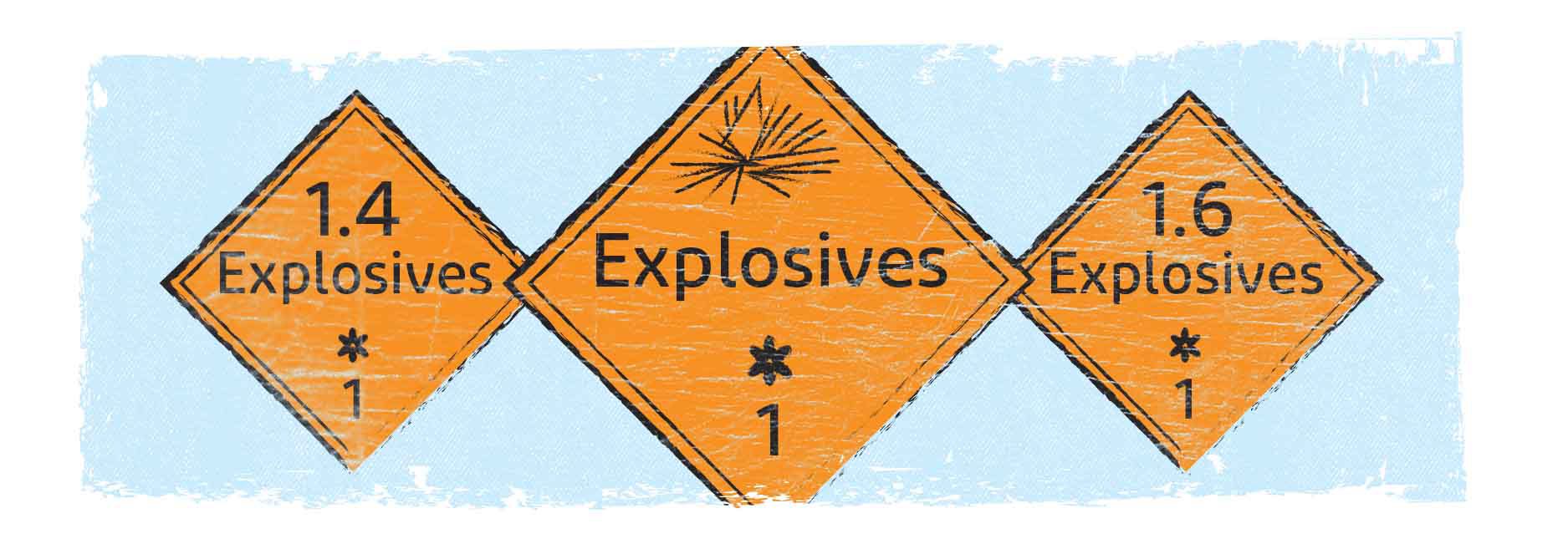Hazmat on the go – Transportation regulations: Explosives
By Kathryn Novelli, Senior Marketing Analyst

Handling and transporting hazardous materials are the reality of a modern and dynamic supply chain. Whether the hazardous cargo is a final product destined for market or a byproduct of the production process that must be disposed of, hazardous materials transportation remains a necessary part of contemporary commerce.
Traveling with hazardous materials is serious business and maintaining safety is of the utmost importance. To help workers stay safe, the United States Department of Transportation (DOT), , and its operating organizations oversee regulations and requirements for the safe transportation of hazardous materials.
The Federal Motor Carrier Safety Administration (FMCSA) was established within the U.S. DOT in 2000 in accordance with the Motor Carrier Safety Improvement Act of 1999. The primary mission of the FMCSA is . The FMCSA works with federal, state and local enforcement agencies and oversees commercial drivers' license (CDL) administration, regulatory compliance, research and technology development and commercial motor vehicle operator assistance programs to improve the safety of commercial motor drivers, operations and vehicles.
Additionally, the Pipeline and Hazardous Materials Safety Administration (PHMSA), created in 2004, works . The PHMSA establishes national policy, sets and enforces standards, educates, conducts research and helps prepare the public and first responders to prevent and respond to hazmat incidents.
The FMCSA and PHMSA work in tandem to advise and enforce regulations in relation to the DOT’s :
- Class 1: Explosives
- Class 2: Gases
- Class 3: Flammable Liquid and Combustible Liquid
- Class 4: Flammable Solid, Spontaneously Combustible and Dangerous When Wet
- Class 5: Oxidizer and Organic Peroxide
- Class 6: Poison (Toxic) and Poison Inhalation Hazard
- Class 7: Radioactive
- Class 8: Corrosive
- Class 9: Miscellaneous
The first stop on our Hazmat on the Go series is Class 1: Explosives.
Explosives include . Common explosives include gunpowder, fireworks and dynamite. Explosives are also found in automotive airbag inflators, special industrial tools, fire extinguishers and certain pest control devices. Regulations and law enforcement for explosives are primarily overseen by the U.S. Bureau of Alcohol, Tobacco, Firearms and Explosives (ATF), but , in conjunction with FMCSA regulations.
The DOT designates explosives as a Class 1 hazardous material, which is further categorized into , generally becoming less hazardous as the division number increases:
- Division 1.1: Explosives which have a mass explosion hazard
- Division 1.2: Explosives which have a projection hazard but not a mass explosion hazard
- Division 1.3: Explosives which have a fire hazard and either a minor blast hazard or a minor projection hazard or both, but not a mass explosion hazard
- Division 1.4: Explosives which present no significant blast hazard
- Division 1.5: Very insensitive explosives with a mass explosion hazard
- Division 1.6: Extremely insensitive articles which do not have a mass explosion hazard
These classifications are used for cargo labeling and vessel placarding, .
DOT regulations for transportation of explosive materials differ by division. For example, are prohibited from parking on private property without the consent of the property owner, as well as parking on or near public, densely populated or frequently traveled areas, unless essential to a work operation.
In the case of accidents during transport, PHMSA advises on emergency response actions for fires, spills or leaks and first aid. Specifically, .
Fortunately, thanks to the diligent efforts of government regulators, enforcers and hazmat transporters, . For example, , a truck transporting 18,000 kilograms (40,000 pounds) of blasting explosives went off the road and immediately started a fire. About 35 minutes after the accident, the truck exploded, causing two minor injuries, damaging several houses and throwing fragments of the truck as far as 2,740 meters (5,800 feet). Firefighters were in contact with the Canadian Transport Emergency Centre (CANUTEC), who advised against approaching the scene. The driver’s warning and the explosive placards on the truck helped inform the decision to evacuate the area, which prevented fatalities and serious injuries.
Knowledge of transportation regulations and best practices for hazardous materials is paramount to keeping people safe on and off the road. Through diligent adherence to safety standards and awareness of emergency response procedures, hazmat transporters can help keep roads safe for everyone.
To learn more about how to protect yourself from different hazardous materials and to find out which k8ÓéÀÖ products offer suitable protection for your needs, visit .
Do you have a story you’d like to share about transporting hazardous materials? Email kathryn.novelli@dupont.com to discuss being featured in our next edition of The Glow Worm.
